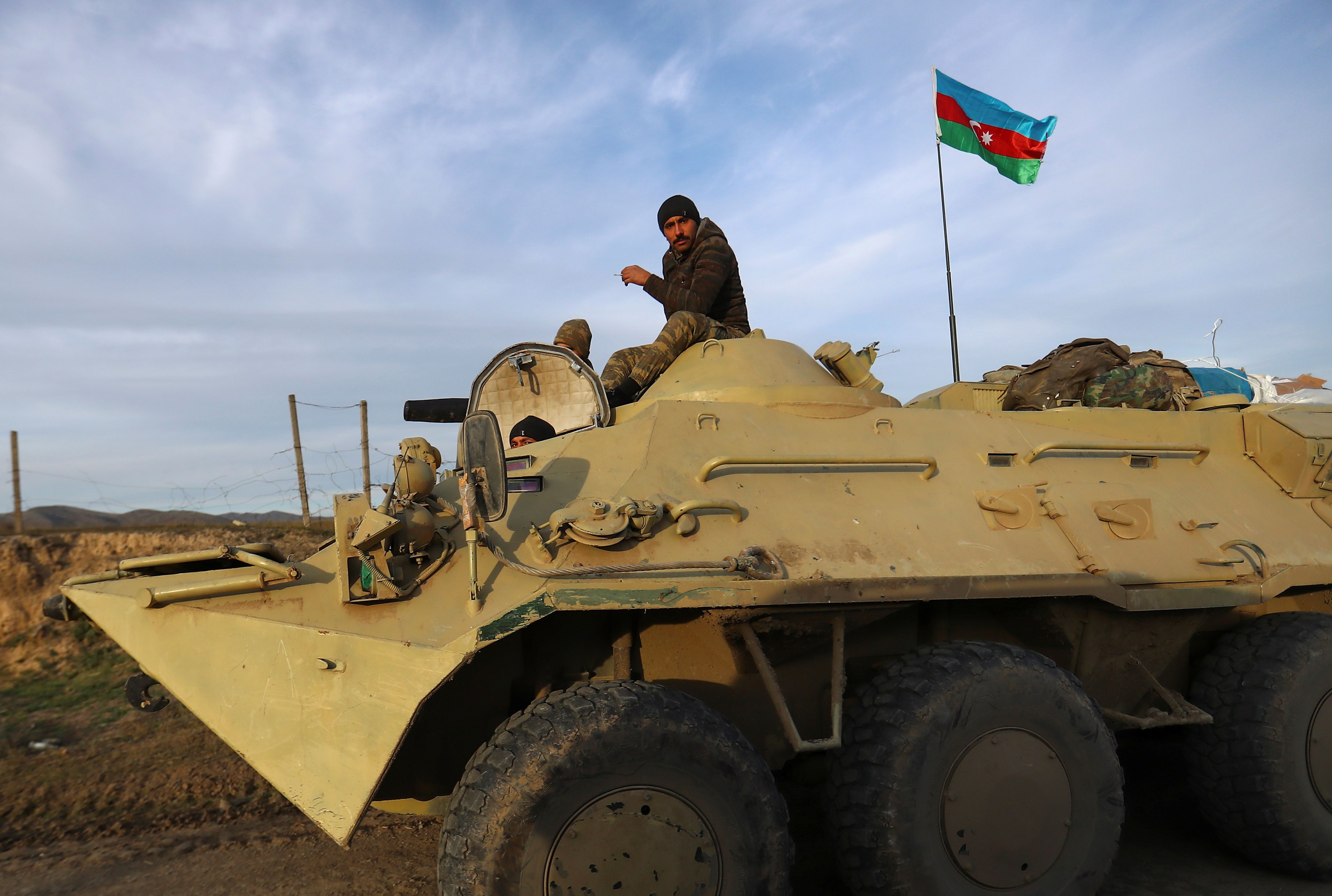The Military Dimension of the Conflict over Nagorno-Karabakh

On 27 September, Azerbaijani troops launched an offensive to the north of the contact line separating the territory of NK (a quasi-state then under Armenian control) and Azerbaijan and on the southern section of the direct border between Armenia and Azerbaijan. In the following days, the main Azerbaijani forces shifted to the southern area of the contact line where they broke through the Armenian defences, cut off NK from the border area with Iran, and entered the territories occupied by the Armenians. On 9 November, they captured the strategic city of Shusha, which made it possible to continue the offensive deep into NK territory and take it in its entirety. That evening, under the auspices of Russia, Armenia and Azerbaijan concluded a truce, ending the fighting and giving Azerbaijan control over about 75% of the territory of NK.
Azerbaijan’s Offensive
Azerbaijan has greater military potential than Armenia. Its armed forces number about 130,000 troops—twice as many as Armenia—and about 850,000 reservists (four times more). In addition, Azerbaijan, unlike Armenia, has maintained high defence spending for more than a decade. In 2019, it was about 3.8% of GDP, at $1.8 billion, or three times what Armenia spent, which made it possible to modernise Azerbaijan’s Armed Forces. Azerbaijan also has reduced its dependence on supplies of arms from Russia by increasing imports from Turkey and Israel, among others. This included purchases of systems not available from Russia, including Turkish Bayraktar TB2 drones. In turn, organisational and personnel changes in Azerbaijan’s special services and the army after 2015 limited Russian influence and military officials in favour of new cadres educated in Turkish and Pakistani military academies, which prepared the state for the military recovery of NK.
After 2015, Turkey became Azerbaijan’s main military ally and provided significant support during the offensive in NK, including providing about 5,000 Syrian-based mercenaries from a special purpose unit, the Hamsa Division. Turkish military advisors stationed in Azerbaijan also provided their allies with information about how to effectively use Turkish combat drones to attack Russian-made armaments (in Armenia), learnt during operations in 2018 in Syria (Olive Branch) and 2020 (Spring Shield) in Libya. They also shared their experiences from participation in the 2001 NATO intervention in Afghanistan in conducting activities in mountains and counterinsurgency. Azerbaijan’s offensive was preceded by intelligence and reconnaissance activities on the territory of its enemy.
The Turkish Bayraktar TB2 combat drones allowed Azerbaijan to destroy key weaponry used by the Armenian forces, including rocket launchers and armoured vehicles. The Bayraktar TB2 are MALE-class drones (medium altitude, long range), capable of autonomous flight and carrying explosives, including guided missiles (MAM-L and MAM-C). They were also used for reconnaissance activities, targeted killings (including the NK defence minister) and attacks beyond the front lines.
Azerbaijan also successfully used Special Forces operating in small groups. The use alone of mechanised troops with weapons similar to those used by Armenia (tanks, infantry fighting vehicles, artillery systems) would not have given Azerbaijan such a significant advantage. Automated command systems made in Israel and Turkey were important. The NK operations were accompanied by electronic reconnaissance (signals intelligence or SIGINT, including surveillance of the GSM network), which enabled the acquisition of up-to-date information about the enemy’s activities.
Why Armenia Lost
Compared to Azerbaijan, Armenia had less equipment and little ability to conduct electronic warfare (EW). In addition, Prime Minister Nikol Pashinyan’s harsh rhetoric towards the military since 2018 and the announcement of radical reforms led to the departure of many experienced commanders, which reduced the effectiveness of the military’s response in NK.
Armenia also ignored signals that Azerbaijan was preparing for a large-scale operation in NK, including intelligence information about the mobilisation of Azerbaijani forces. Moreover, the Armenian positions were not only well-recognised by Azerbaijan but were not well-protected, especially in the initial phase of the conflict, for example, against attacks by combat drones or “loitering munitions” (kamikaze drones).
Defence planning errors are also responsible for the defeat—access to NK was protected only by one line of fortifications, which the Azerbaijani forces interrupted and then easily moved deeper into the region. Moreover, the fortifications were developed mainly in the north of NK, and not in the south, where the topography is a much smaller obstacle to land operations, including armour. The errors in command and limited resources meant the Armenian forces were not ready with reconnaissance and counter-offensive operations. There was no attack on the rear of the Azerbaijani forces and the Armenian units retreated very quickly under the attack without resistance at strategic points and abandoning operational weapons. This was combined with problems with the transport of Armenian units from the north to the south of NK and with medical support on the front line once Azerbaijan took control of key transport corridors and the airspace in the area of operations. Only once the situation of the defending units in NK was already very difficult did Armenia use missile systems (including Iskander-E types) to attack Azerbaijan’s second-largest city—Ganja—but it did not stop the Azerbaijani offensive. However, Armenia did not significantly escalate these attacks, such striking the capital, Baku, or oil pipelines or dams.
Moreover, while Azerbaijan could count on support from allied Turkey, Russia decided not to provide similar assistance to Armenia, despite both being members of the CSTO military alliance. At the same time, as a result of the truce, Russian units from the 15th Separate Motorised Rifle Brigade of the Central Military District took control of NK as peacekeepers.
Conclusions for NATO
The success of the Azerbaijani offensive was possible because of a technological advantage, the speed of operations resulting from the short front line, and the choice of an effective offensive tactic. The Azerbaijani-Armenian clashes revealed the susceptibility of traditional land-based units (armoured and mechanised formations) to hunter-killer drones if they lack kinetic (anti-aircraft missiles) and EW systems. Azerbaijan achieved success also thanks to effective military intelligence and reconnaissance, maintenance of communications systems and the use of mobile special forces. The Azerbaijani forces’ higher combat capabilities resulted from the intensification of training and technological and intelligence cooperation with Turkey.
The war in NK revealed the effectiveness and prospect of the use of combat drones and loitering munitions, as well as automated tactical command-and-control systems used by Azerbaijan. These are more and more important elements of the modern battlefield.
Therefore, EW systems, including airspace monitoring and scanning devices, as well as kinetic air-defence systems, will be of increasing importance for flank states such as Poland. A growing challenge is the need for efficient and cost-effective defence against the use of drones and loitering munitions, not the use of the most powerful anti-aircraft and anti-missile systems. They may be supported by activities in cyberspace (attacks on enemy IT systems) and EW. On the other hand, rapid investments in combat drone technology, enabling not only reconnaissance but also close air support for infantry units and the ability to eliminate enemy armoured vehicles, should be seriously considered. It is also necessary to develop the security of basic military communication and battlefield-management systems.



